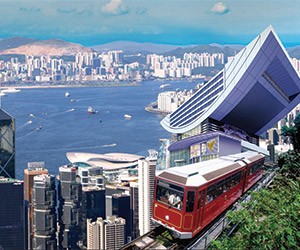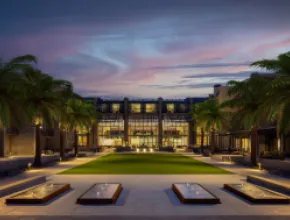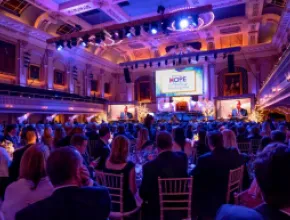Somewhere between the black fungus and wasabi small plate and double- boiled soup with mushroom and bamboo, I’ve lost track of how many courses have passed my palate. I am too busy watching the wait staff at Ming Court busily prepare baskets of dim sum and their award-winning fried rice casserole—magically turning Hong Kong street food into Michelin-star fare.
Ming Court, at the Langham Place Hong Kong, is one of more than 11,000 restaurants in Hong Kong, aptly known as the “Culinary Capital of Asia.” Though a person would need to spend more than nine years, eating three meals a day, to try them all, there is an array of interesting ways for groups to experience Hong Kong cuisine, and the options are expanding.
Traditionally known for its Cantonese stir-fry, dim sum, congee, hotpots, Hong Kong-style milk “pantyhose” tea and other local delights, Hong Kong now ranks as a true international dining hot spot, helped to prominence when Michelin released the first Michelin Guide Hong Kong Macau in 2009. In the most recent edition, 48 Hong Kong eateries rated one star and 14 scored two or three stars.
“Hong Kong is special. It’s a small place that accepts people from all over the world,” says chef Jacky Yu, who runs private kitchen Xi Yan. “Chinese cuisine has a high standard here, but it’s a place where cuisine from everywhere can make noise.”
Celebrity chefs are making their mark on Hong Kong’s culinary scene, mainly in top-end hotels. A short list includes Pierre Gagnaire at Mandarin Oriental Hong Kong’s Pierre, Richard Ekkebus at Amber, located at the Landmark Mandarin Oriental Hotel, and Nobu Matsuhisa at Nobu Hong Kong in the InterContinental Hong Kong, which is also home to Alain Ducasse’s Spoon.
Nouveau molecular cuisine is even making a splash with Alvin Leung Jr.’s creations—nicknamed Alvin’s X-treme Chinese Cuisine—at Bo Innovation.
The result has placed the spotlight on Hong Kong’s dining scene as a whole, from the most elite upscale establishments to the local tea houses, or cha chaan teng, and hawker stalls, or dai pai dong.
“The consequence of celebrity chefs is that the image is higher for everyone,” says Chow Kuen Chung, chief executive chef at Super Star Seafood Restaurant, a traditional Cantonese establishment that excels at dim sum and boiled crab as well as the rarely served stone fish.
Now local Hong Kong chefs are being recognized around the world, such as chef Kinsen Kam of Yung Kee fame, noted for its barbecue goose.
DMCs like Destination Asia can arrange group cooking demonstrations and chef talks for meetings and incentives, according to Katie Buxton, general manager of the Hong Kong office of Destination Asia.
They can also arrange meals at some of the city’s members-only venues such as the China Club, located in the old Bank of China Building in Central and well known for its Saturday brunches.
Private kitchens such as Xi Yan and Yin Yang, where Chef Margaret Xu focuses on innovative regional cuisine, are a growing trend in Hong Kong and are well suited for group dinners and functions.
“The idea is come to my house and I will cook for you,” Xi Yan’s Yu says of his private kitchen.
Yu integrates food styles from his travels, from Beijing to Shanghai to Japan, and focuses on clean and sustainable ingredients, such as faux shark fin soup.
View from the Top
Another trend among groups is dining with a view. Earning three Michelin stars, Lung King Heen, which translates to View of the Dragon, looks out on the Hong Kong skyline from the fourth floor of the Four Seasons Hotel Hong Kong. Groups take in the views while dining on creative dim sum, such as pork buns with pine nuts.
The M bar at the Mandarin Oriental takes its views even higher, serving fusion-style drinks such as the Earl Grey Mar-tea-ni on the 25th floor. Not to be outdone, Aqua Tokyo and Aqua Roma overlook a glittering Victoria Harbour and offer groups the option of private dining areas. The evening often starts with an artisan cocktail at its sleek Aqua Spirit bar.
The Aqua Group also runs the Aqua Luna red-sail Chinese junk boat, which groups can book for cocktail cruises during the nightly Symphony of Lights sound and light show on the harbor.
For cocktails with a view, Sevva occupies the 25th-floor penthouse of the Princes Building overlooking the harbor. Fruity concoctions can be sipped on the wraparound terrace, while inside there is the Taste Bar for drinks, tapas and live music.
Touted as the highest bar in the world, Ozone occupies the 118th floor of The Ritz-Carlton, Hong Kong, pouring signature cocktails and serving Asian tapas, while DJs spin a variety of beats.
Across the harbor, the Peninsula Hotel’s bar at the Felix Restaurant commands harbor views from the 28th floor.
One of the ultimate views in Hong Kong is from Cafe Deco Bar & Grill, set atop The Peak, Hong Kong’s most popular attraction. Groups can rent out its two floors and rooftop terrace.
Cooking Classes
Aside from consuming Hong Kong’s cuisine, a number of companies run cooking classes for groups. For the past eight years, 6 Senses Cooking Studio has offered a variety of team-building options.
“Cooking food is the basic need of daily life, and through cooking and eating we communicate,” says Denice Wai, director of 6 Senses Cooking Studio.
During my visit, the contest was judged on presentation, and teams worked hard to be fast and creative. Different programs are possible, including a visit to a “wet” market to buy the ingredients.
“That introduces them to the local culture and lets them understand local community and lifestyle,” Wai says. “Each group picks up ingredients and they do everything on their own, from washing to marinating. You can really see the communication happening.”
Sometimes participants are given ingredient names in Chinese and they have to ask the locals at the market how to find them.
The 6 Senses kitchen hosts up to 40, or Wai can bring the event to a hotel for up to 200.
The InterContinental Hong Kong takes advantage of its lineup of star chefs with a Cooking with the Culinary Stars program. The hotel can work with group requests.
DMCs can arrange other team-building options, including a Create Your Own Menu program, where teams are given a budget and sent off to fishing villages to buy fresh seafood or given a series of clues to arrive at a designated village restaurant.
Several districts cater to group dine-arounds, including SoHo, the Lan Kwai Fong entertainment district and Knutsford Terrace, all offering a variety of Western and local dining options as well as trendy bars.
Groups can also make the trip to Sai Kung in the New Territories for alfresco seafood, as well as to Aberdeen, another fishing village that is home to the Jumbo Floating Restaurant, which also arranges cooking classes.
Wine Culture
In 2008, Hong Kong abolished its wine tax and now imports over 20,000 brands, making way for a wine boom. Though no vineyards actually exist in Hong Kong, it is now the world’s largest center for wine auctions.
“Hong Kong is one of the world’s largest wine markets, and drinking it has started to become a cultural habit for locals,” says Paul Hsu, executive director of Elite Concepts, which runs a number of local hotels, including Guo Fu Lou, replete with a wine cellar that offers over 100 different types of wine.
The company’s Ye Shanghai restaurant in Kowloon offers wine and chocolate pairings, featuring handmade chocolate that integrates a variety of Chinese teas. The restaurant also helps pair its Shanghainese cuisine with Western wines.
To make its own wine, 8th Estate Winery sends its vintners to source grapes from a variety of countries. The grapes then undergo a flash freezing process before being shipped to Hong Kong, where 8th Estate produces its wine.
Groups can arrange wine tasting at the winery or organize an event on the premises. With 4,000 square feet of venue space, there is ample room for cocktail receptions, banquets and corporate functions. The Barrel Room, with wood tables and oak barrels, can be used for receptions and sit-down dinners, while the outdoor terrace is open to dinner parties.
Crown Wine Cellars, a UNESCO Asia Pacific Heritage Site, features six underground cellars and a private members clubhouse, comprising two underground bunkers and a conservatory. The original structures were constructed almost 70 years ago by the British military to serve as an ammunition and weapons storage depot in preparation for World War II.
The conservatory measures roughly 1,500 square feet and can be used for pre-dinner cocktails, and the main bunker can host midsize groups for tastings and receptions. The Library, showcasing World War II and other memorabilia, suits small groups for dinners.
Farms and Markets
To get a taste of traditional foods, groups can arrange tours of local food markets, such as Dried Seafood Street, which brims with more than 300 shops selling everything from salted dried fish to antler.
Another option is a group tour with Experiencing Organic Farming Programme, visiting organic gardens in the New Territories. Farmers talk to groups about cultivation techniques, while hands-on programs include food tasting and cultivation.
Food festivals are popular in Hong Kong, and groups can arrange visits around one of many culinary extravaganzas, including the annual Hong Kong Wine and Dine Festival, featuring over 200 booths and the Grand Tasting Pavilion for oenophiles.
The Hong Kong Food Festival takes place over the holiday season, while the Lei Yue Mun Seafood Festival occurs annually in September in the fishing village of the same name on Kowloon. Aside from the village’s famed seafood, the festival includes Cantonese opera and lion dances.
As existing and new chefs continue to fuse a mix of culinary cultures in Hong Kong, the rest of us benefit from nearly a decade’s worth of restaurants—not to mention other foodie diversions—to discover.
Marlene Goldman is a former Meetings Focus editor currently based in Singapore. One of her recent adventures in Asia was eating her way through Hong Kong and sampling a few wines along the way.







